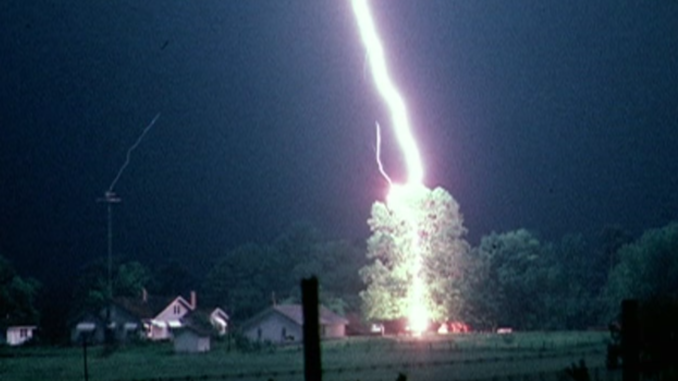
Only relatively recently has it become known to science that some of nature’s most extreme examples of lightning even exist. Superbolt lightning – also sometimes referred to as ‘bolts out of the blue’ – is defined as lightning so intense that it’s at least 100 times brighter and more intense than ordinary lightning, and may be more than 1,000 times brighter and more intense.
Lightning, whether we’re talking the common variety or the superbolt kind, is generated when a huge negative charge (a large number of free electrons) and a huge positive charge (a large number of ions) seek to get together. In other words, atoms or molecules which are lacking a full complement of electrons (we call these ions) seek to acquire free electrons. When an ion captures an electron, it’s positive charge is cancelled out by the electron’s negative charge, resulting in an atom or molecule with a neutral charge.
Well, that’s all well and good, but where do these ions and free electrons come from? It starts with the water cycle. When water is heated, typically by the Sun, it evaporates – becomes a vapor when it changes states from a liquid to a gas – and rises. As the water vapor rises up into the air it cools. The higher the altitude, the colder it gets. When it cools sufficiently the water vapor changes state again, this time from a gas back into a liquid (water droplets suspended in air) that we observe as a cloud in the sky. As the H2O rises even higher, it’ll change states into a solid: ice crytals. This cloud we see from the ground takes the shape of an anvil: the classic shape of clouds that produce thunderstorms. (When rainfall from the thunderstorm falls to earth and returns to a body of water, such as where it started from by evaporation, the water cycle is complete.)
Now we have an anvil cloud, with a whole lot of activity going on inside. It can become quite violent, with strong updrafts and downdrafts, water vapor rising, water droplets (rain) falling, ice crytals forming, and vertical winds tossing water, sleet, and ice, up higher and higher. All these many water molecules (in vapor, liquid, and solid forms) being energetically jostled around and bumping into one another, release electrons when they collide. The electrons are now free, and each H20 molecule that gave up an electron is now a positively-charged ion. According to theory, free electrons gather at or near the bottom of the cloud, while ions are carried on powerful rising air currents to the top of the cloud, creating what’s called ‘charge separation’. Our anvil cloud now is very much like a battery or a capacitor, with the positive end at the top and the negative end at the bottom.
The number of free electrons at the bottom of the cloud becomes so great that free electrons (negative charge) on and in the ground below the cloud are repulsed and ions (positive charge) on the ground are attracted to the electrons at the bottom of the cloud. When the electrical force becomes great enough to overcome the natural resistance of the air, a path through the air itself ionizes (becomes a plasma) and ordinary lightning strikes between the cloud and the ground below. Lightning can also strike between clouds (that is, from one cloud to another), within a cloud, and from cloud to air (which seems to be a case of a bolt of lightning failing to find a path to ground or another cloud).
“The Birth of a Lightning Bolt” (2:05):
Now that we understand the theory of common lightning, let’s find out how superbolt lightning is different. Recall that the positively-charged ions are concentrated at the top of the thundercloud. Though far rarer than common lightning (where the cloud is negatively charged and the ground is positively charged), superbolt lightning occurs between the positive charge at the top of the cloud and a negative charge on the ground, usually many miles away from the thunderstorm. This is why superbolt lightning is often referred to as ‘bolt out of the blue’, because of the blue sky above the person or object that is struck by the superbolt, possibly 25 miles or more away from the source thundercloud.
Superbolts are rare in comparison to ordinary lightning, by a ratio of one in 2 million lightning stikes. That’s fortunate, given their intensity and power such as demonstrated in the late 1970s:
A “superbolt,” which is a lightning flash so powerful that it can release as much energy as a small nuclear weapon, may account for what was orignally thought to be a nuclear detonation near South Africa last month, some scientists now believe.
The New York Times
Several dozen superbolts have been identified in recent years by bomb‐monitoring Vela satellites, one of which made the Sept. 22 observation. Such lightning flashes, with 100 times more energy than a normal bolt, occur chiefly over water, which is why their existence had not previously been recognized.
From the same NYT article:
A destructive superbolt struck Bell Island, off Newfoundland, on April 2 of last year, and scientists from Los Alamos were sent to investigate. According to Dr. Thomas Gold of Cornell University, who also went there, the bolt left a one‐mile swath of damage. Trees were split; television antennas were twisted beyond recognition; transformers were shattered and circuit breakers hung from power‐line poles, and there were craters in the new‐fallen snow.
The New York Times
“Geeking Out: Bolt out of the blue” (1:14):
“The Mystery of Superbolt Lightning” (2:33):
“Rare ‘Superbolts’ of Lightning Are Real, and Have an Unusual Origin Story” (1:28):
Question(s) of the Night: Have you ever been struck by lightning? How likely are you to take risks associated with lightning strikes?
